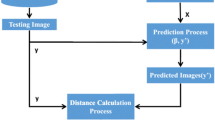Abstract
Eigenface (PCA) and Fisherface (LDA) are two of the most commonly used subspace techniques in the area of face recognition. PCA maximizes not only intersubject variation but also the intrasubject variation without considering the class label even if they are available. LDA is prone to overfitting when the training data set is small, which wildly exists in face recognition. In this work, we present a binary feature selection (BFS) method to choose the most suitable set of eigenfaces for classification when only a small number of training samples per subject are available. In the proposed method, we make use of class label, look on two subjects as a group, and then the most suitable eigenfaces that help to identify these two subjects are picked out to form the binary classifier. The final classifier is the integration of these binary classifiers by voting. Experiments on the AR and AT&T face databases with small training data set prove that our proposed method outperforms not only traditional PCA and LDA but also some state of the art methods.








Similar content being viewed by others
Reference
Adini Y, Moses Y, Ullman S (1997) Face recognition: the problem of compensating for changes in illumination direction. IEEE Trans Pattern Anal Mach Intell 19(7):721–732. doi:10.1109/34.598229
Zhao W et al (2003) Face recognition: a literature survey. ACM Comput Surv 35(4):399–458. doi:10.1145/954339.954342 (CSUR)
Chellappa R, Wilson CL, Sirohey S (1995) Human and machine recognition of faces: a survey. Proc IEEE 83:705–740. doi:10.1109/5.381842
Brunelli R, Poggio T (1993) Face recognition: feature versus templates. IEEE Trans Pattern Anal Mach Intell 15(10):1042–1052. doi:10.1109/34.254061
Turk M, Pentland A (1991) Eigenfaces for recognition. J Cogn Neurosci 3:72–86. doi:10.1162/jocn.1991.3.1.71
Turk M, Pentland A (1991) Face recognition using eigenfaces. Proceedings IEEE conference on Computer Vision and Pattern Recognition 586–591
Belhumeur PN, Hespanha JP, Kriegman DJ (1997) Eigenfaces versus Fisherfaces: recognition using class specific linear projection. IEEE Trans Pattern Anal Mach Intell 19(7):711–720. doi:10.1109/34.598228
Zhao W, Chellappa R, Krishnaswamy A (1998) Discriminant analysis of principal components for face recognition. Proceedings of the IEEE International Conference on Automatic Face and Gesture Recognition. pp 336–341
Joliffe IT (1986) Principal component analysis. Springer, New York
Kim HC, Kim D, Bang SY (2003) Face recognition using LDA mixture model. Pattern Recognit Lett 24(15):2815–2821. doi:10.1016/S0167-8655(03)00126-0
Swets D, Weng J (1996) Using discriminant eigenfeatures for image retrieval. IEEE Trans Pattern Anal Mach Intell 18(8):831–836. doi:10.1109/34.531802
Manli Zhu, Aleix M Martinez (2006) Selecting principal components in a two-stage LDA algorithm. CVPR 2006
Perlibakas V (2004) Distance measures for PCA-based face recognition. Pattern Recognit Lett 25(6):711–724. doi:10.1016/j.patrec.2004.01.011
Lu J, Plataniotis KN, Venetsanopoulos AN (2005) Regularization studies of linear discriminant analysis in small sample size scenarios with application to face recognition. Pattern Recognit Lett 26(2):181–191
Lu J, Plataniotis KN, Venetsanopoulos AN (2003) Face recognition using LDA based algorithms. IEEE Trans Neural Netw 14(1):195–200. doi:10.1109/TNN.2002.806647 (Medline)
Lu J, Plataniotis KN, Venetsanopoulos AN (2003) Face recognition using kernel direct discriminant analysis algorithms. IEEE Trans Neural Netw 14(1):117–126. doi:10.1109/TNN.2002.806629 (Medline)
Martinez A, Benavente R (1998) The AR database, CVC Technical Report NO. 24
Yang J, Zhang D, Frangi AF, Yang JY (2004) Two-dimensional PCA: a new approach to appearance based face representation and recognition. IEEE Trans Pattern Anal Mach Intell 26(1):131–137. doi:10.1109/TPAMI.2004.1261097 (Medline)
Zhang D, Zhou Z (2005) (2D)2PCA: two-directional two-dimensional PCA for efficient face representation and recognition. Neurocomputing 69:224–231. doi:10.1016/j.neucom.2005.06.004
Tan X, Chen S, Zhou Z-H, Zhang F (2004) Robust face recognition from a single training image per person with kernel-based SOM-face. Proceedings of the 1st International Symposium on Neural Networks (ISNN’04), Lecture Notes in Computer Science, vol 3173, pp 858–863
Acknowledgments
Authors would like to express heartfelt gratitude to 973 Project (2005CB724303) of China for the financial support and our sincere thanks to our colleagues for their continuous and generous support.
Author information
Authors and Affiliations
Corresponding author
Rights and permissions
About this article
Cite this article
Yu, W., Wang, Z. & Chen, W. Selecting discriminant eigenfaces by using binary feature selection. Neural Comput & Applic 19, 911–918 (2010). https://doi.org/10.1007/s00521-010-0381-9
Received:
Accepted:
Published:
Issue Date:
DOI: https://doi.org/10.1007/s00521-010-0381-9




